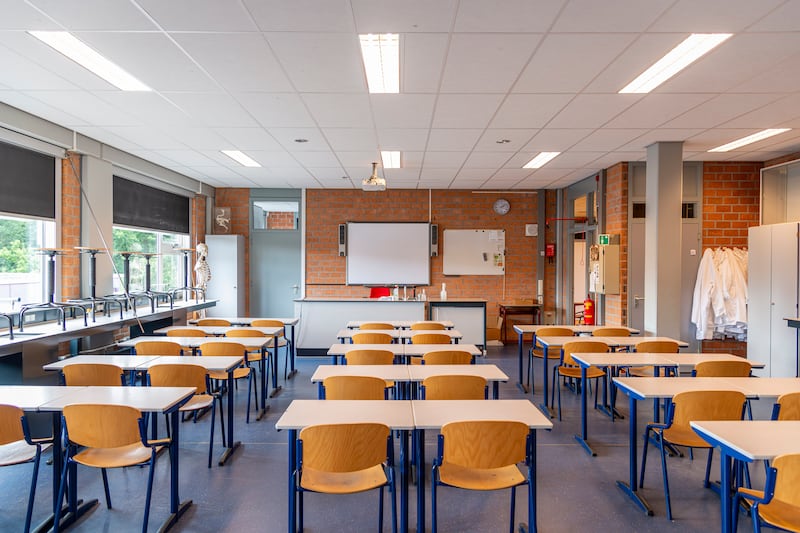Like so many school principals these days, Kathryn Corbett spends too much of her time scrambling to find cover for teachers.
“We are finding that we can fill fixed-term posts, but it’s the maternity leave cover, parental cover or carer’s leave that are proving less attractive,” says Corbett, principal of Bishop Galvin National School in Templeogue, Dublin. “And it’s getting harder every year to fill these short-term positions.”
With three days to go before the start of the school year, Corbett still had no teacher for a mainstream class.
“So, we had to look at putting a support teacher in for the short-term – a very difficult decision,” Corbett says. “In one case, we were lucky to get a teacher for three months before she went on career break. It is frustrating for everyone, but the shortages are beyond my control. That makes it hard, but our teachers, board of management, and the whole community generally do understand.”
RM Block
Yet, teaching in Ireland has never been more popular – or so it would seem.
Last year there were record numbers of registrations with the Teaching Council, with about 3,200 signing up. CAO points for entry to initial teacher education courses are high and hover in the high-400s or low-500s. The profession remains a high-status one, particularly compared to other countries.
And yet, schools across the country are reporting significant staffing shortages, problems recruiting qualified teachers and a drop in the numbers applying for jobs.
At primary level alone, there are 800 vacancies nationwide, of which 500 are in Dublin. Meanwhile, a survey of school leaders conducted by the Teachers Union of Ireland (TUI) – which represents teachers in post-primary schools – found that 77 per cent had advertised a job and received no application, and that 64 per cent had unfilled vacancies in their schools.
What is causing this disconnect? Where have all the teachers gone? What problems is this causing in the short term? And are there any solutions?

“For a number of years, we have worked with the Higher Education Authority to ensure that there is an increased number of students coming into the [postgraduate] professional masters of education course,” says Dr Majella McSharry, who works primarily on post-primary teacher training programmes at Dublin City University (DCU).
“A lot of this was predicted, because we knew there would be a demographic bulge which will peak this year (2024). Whether that planning started early enough remains to be seen.
“Ireland has never had a problem with the status of teachers, and it has always been a highly valued profession in Ireland, attracting the best and brightest. But the problems in attracting teachers are multifaceted.”
Ireland’s booming economy means that there are job shortages across multiple sectors. Teaching is no different.
“Because teaching is a high-points course, teachers are clever and have a lot of academic ability,” says Michael Murphy, principal of Mayo College of Further Education and Training, as well as president of the principals and deputy principals association within the TUI. “This means they have a lot of transferable skills, and so can get higher jobs in other sectors.”
Whereas, for instance, a maths graduate might once have jumped at the chance of a teaching career, they can now get a higher salary in the private sector. The same applies to language, science or even home economics teachers.
Although the starting salary for education graduates is higher than most other professions, it can take a long time for increments to kick in, and the relatively slow – albeit steady – reinstatement of posts of responsibility has left many teachers feeling that their chances for career progression are hampered relative to other industries.
“I think teacher shortages were primarily an urban problem until last year,” says Murphy. “But now we are seeing shortages in western areas, including towns like Castlebar. Most teachers starting out are younger, and they don’t want to spend all their money on rent or mortgages.”
McSharry points out that although teacher salaries are slightly higher in Ireland than other OECD countries, it still is not enough to pay rent – if they can find accommodation in the first place – or attain a mortgage.
“In my work on the PME, we had students coming in who may have been in other professions pre-pandemic, but some of them are still working extra jobs at evenings and weekends, just to make ends meet. How long is that sustainable for?”
Ireland is not alone: teacher shortages are international and affecting many countries, and it is making the profession a lot more mobile.
“We are bucking a European trend in that we continue to attract a high calibre of candidates to primary education,” says Professor Catherine Furlong, the chair of the Bachelor in Education programme at DCU.
“We are very fortunate in this regard, and our Pisa results show Ireland performing strongly in literacy and maths – but it is also making us victims of our own success. Other countries are looking at the strength of our teachers and trying to attract them. In DCU, we regularly have groups coming to see why our teachers are doing so well, and it makes our teachers attractive to them.”
Young Irish people have always wanted to travel, as clearly evidenced by the size of the Irish diaspora. Today, the highly competitive salaries on offer in some European countries, Australia and elsewhere mean they can potentially earn multiples of what they might take home here.
One flyer aimed at DCU teaching graduates advertised attractive salaries in Germany, relocation support, development opportunities and benefits including gym memberships, lunch and pensions.
In some Arabian peninsula countries, teachers can earn money tax-free – and it is often enough for a deposit on a house. Add in the housing crisis and a generational divide in living standards, and it is not hard to see why many have their eyes on the exit sign.
Russia’s war against Ukraine has seen many refugees fleeing for protection and safety. This has led to Ireland welcoming some 13,750 Ukrainian pupils – a number that is growing – in schools. Meanwhile, more Irish families coming back from overseas has also presented a challenge.
Tackling this problem is very difficult, educators say.

McSharry says that some of it will be resolved through time and demographics while, in the meantime, some schools are condensing teacher timetables to full-time hours in a four-day week so that they do not have to endure long commutes every day.
Some post-primary schools have had to restrict the number of subjects they offer while at primary level, support teachers who should be helping vulnerable students and students with special needs, have had to be reallocated to mainstream classes.
Retired teachers are also being coaxed back, while restrictions on career breaks are being eased and fees for the PME programme reduced from €15,000 to about €13,000.
Corbett says teacher supply panels are a great idea, but few teachers are actually on them, because teachers really want to watch their own class learn and grow.
“And while Ireland is training teachers for the world, the incentive for them to stay abroad is stronger; having posts of responsibility fully restored might help in attracting people to stay,” she says.
Talk of a “Dublin allowance” has also been floated by some teaching union officials – in a bid to address the high cost of accommodation – but any such move would likely require similar measures across the wider public sector.
Murphy believes that the restoration of posts of responsibility to previous levels is key. It will not only help develop future leaders, but provide teachers with the same promotion opportunities available in any other profession.
“We could reduce the bureaucracy in getting Teaching Council accreditation for those from other countries,” Murphy suggests. “We do need vetting, but we could also speed things up.”
Teachers in numbers:
118,432: Total number of teachers on Teaching Council register, its highest ever level
3,600: Estimated net growth of registrants annually
800: Estimated number of vacancies at primary level
64%: Proportion of second-level principals with unfilled vacancies in their schools
Sources: Teaching Council; INTO/IPPN; TUI
- Follow The Irish Times education section on Facebook and X (Twitter) and stay up to date




















